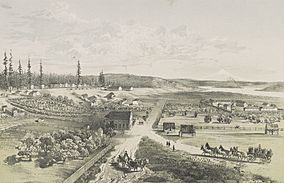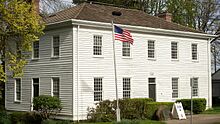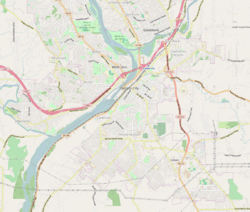Fort Vancouver National Historic Site facts for kids
Quick facts for kids Fort Vancouver National Historic Site |
|
|---|---|

Illustration of Fort Vancouver and its environs in 1855
|
|
| Lua error in Module:Location_map at line 420: attempt to index field 'wikibase' (a nil value). | |
| Location | Vancouver, Washington and Oregon City, Oregon, USA |
| Nearest city | Vancouver, Washington, and Oregon City, Oregon |
| Area | 207 acres (84 ha) |
| Established | June 19, 1948 (national monument) June 30, 1961 (national historic site) |
| Visitors | 710,439 (in 2011) |
| Governing body | National Park Service |
| Website | Fort Vancouver National Historic Site |
Fort Vancouver National Historic Site is a special place in the United States. It helps us remember important parts of American history. This site is located in two states: Washington and Oregon.
The historic site has two main parts. One part is where the original Fort Vancouver once stood in Vancouver, Washington. The other part is the home of an important historical figure, John McLoughlin, in Oregon City, Oregon. Both locations became national historic sites in the 1940s. The Fort Vancouver area became a National Historic Site in 1961. In 2003, it joined with the McLoughlin House to form one larger historic site.
Contents
Discover History at the Visitor Center
The visitor center at Fort Vancouver National Historic Site opened in 1966. It was part of a program to improve national parks. Today, the National Park Service and the United States Forest Service work together to run it.
In 2015, the visitor center was updated. It now provides information for both Fort Vancouver and the Gifford Pinchot National Forest. You can see cool exhibits about old artifacts found at the site. There are also art displays from local Native American artists. The center has a theater that shows two films. One film is about Fort Vancouver, and the other is about the Eruption of Life at Mount St. Helens.
Explore the Old Fort Vancouver Site
The main part of the historic site is Fort Vancouver itself. It is located in Vancouver, Washington, near Portland, Oregon. Fort Vancouver was a very important Hudson's Bay Company (HBC) fur trading post. It was built in 1824.
From 1824 to 1845, John McLoughlin was in charge as the Chief Factor. This fort was the main center for the Hudson's Bay Company's fur trade. Its influence reached from the Rocky Mountains to Alaska, down to Alta California, and even to Hawaii.
In 1846, the Treaty of Oregon was signed. This treaty ended a long argument between the United Kingdom of Great Britain and Ireland and the United States. It set the border between their lands. The treaty allowed the Hudson's Bay Company to keep operating at Fort Vancouver. However, the fort was now in the Oregon Territory of the United States. On June 14, 1860, the Hudson's Bay Company left Fort Vancouver. They moved their operations to places like Fort Victoria in British Columbia.
|
Vancouver National Historic Reserve Historic District
|
|

Pearson Hangar at Vancouver National Historic Reserve.
|
|
| Location | Roughly bounded by an alley N of Officers' Row, East Reserve St., Columbia River, and I-5, Vancouver, Washington |
|---|---|
| Built | 1824 |
| Architect | Hudson's Bay Co.; et al. |
| Architectural style | Late Victorian, Late 19th And 20th Century Revivals |
| NRHP reference No. | 06001216 |
| Added to NRHP | January 5, 2007 |
In 1849, the United States Army built the Vancouver Barracks next to the British trading post. When the Hudson's Bay Company left, the Army took over the area. A fire destroyed the original Hudson's Bay Company fort in 1866. But the Army facility kept operating for many years.
Fort Vancouver became a national monument in 1948. This separated it from the Army barracks. In 1966, Congress made the protected area larger. They also changed its name to a National Historic Site. For a while, the National Park Service managed it as an archaeological site. This meant they focused on studying the remains of the old fort.
However, in 1965, local people asked for the fort to be rebuilt. Congress agreed, and reconstruction began. All the fort buildings you see today are modern copies. But they are built exactly where the original structures stood. The Park Service also created the Vancouver National Historic Reserve Historic District. This includes the rebuilt fort, historic Army buildings, and Park Service structures.
Visit the McLoughlin House Site
|
McLoughlin House National Historic Site
|
|
 |
|
| Location | McLoughlin Park, between 7th and 8th Sts., Oregon City, Oregon |
|---|---|
| Area | 0.6 acres (0.24 ha) |
| Built | 1845 |
| NRHP reference No. | 66000637 |
| Significant dates | |
| Added to NRHP | October 15, 1966 |
| Designated NHS | 1941 |
The McLoughlin House unit includes two homes. These are the McLoughlin House and the Barclay House. The Barclay House belonged to Dr. Forbes Barclay, an explorer and friend of McLoughlin. These two homes are next to each other. They sit on a high piece of land overlooking the Willamette River in Oregon City. John McLoughlin himself set aside this land for public use in the 1840s.
In 1846, McLoughlin stopped working for the Hudson's Bay Company. He bought land on the Willamette River in Oregon City. He built his house there and lived in it until he passed away in 1857. The house is a two-story colonial mansion. It looks like homes from the East Coast during that time.
After McLoughlin's death, his wife lived in the house for three more years. Their family sold the house in 1867. Later, it became a hotel. In 1908, a paper mill wanted to expand and planned to tear down the house. But people who cared about preserving history saved it in 1909. They raised over $1,000 to protect it. In 1910, the house was moved from the riverfront. It was placed on the bluff where it stands today. From 1935 to 1936, the house was restored. It then opened as a museum.
The Barclay House was built in 1849. It was built by John L. Morrison, a carpenter from Portland. Dr. Barclay and his family lived there. Barclay died in 1874. His family owned the house until 1930. It was then moved next to the McLoughlin House. Today, the Barclay House holds museum offices and a gift shop.
The McLoughlin House became a National Historic Site in 1941. In 2003, both homes became part of the Fort Vancouver National Historic Site. The McLoughlin House is located on the Oregon National Historic Trail. This trail is part of the National Trails System. John McLoughlin and his wife are buried on the property. The house has both original and old-fashioned furniture.
Soar Through History at Pearson Air Museum
The Pearson Air Museum opened in 1996. It is located in a historic hangar. The museum and The Jack Murdock Aviation Center show the history of aviation in the Vancouver area. They focus on Pearson Airfield.
Today, the Pearson Air Museum displays several aircraft. One is a De Havilland DH-4 Liberty. It has been restored to look like a plane from the US Army Air Corps 321st Observation Squadron. This squadron was at Pearson Airfield in the 1930s. In June 2018, volunteers finished building a copy of Silas Christofferson's Curtis Pusher plane. The original plane flew from a hotel roof in Portland to what is now Pearson Airfield. The replica is now on display at the museum.
Other exhibits feature the US Army Spruce Production Division. You can also learn about the first flight over the North Pole. This flight landed at Pearson Field in 1937. It came all the way from Moscow, Russia. Models of the Russian Tupolev ANT-25 plane from that flight are at the museum. The museum also has a Fleet Model 2 plane. This plane was flown by Leah Hing, the first Chinese American woman to get a pilot's license.
In 2007, a special pedestrian bridge was built. It goes over the Lewis and Clark Highway. This bridge connects the historic site to the Columbia River.
Discover Vancouver Barracks
Some parts of the Vancouver Barracks became part of the National Park Service in 2012. This happened when the US Army Reserve officially closed the post. The Army had been there continuously since 1849. The buildings are usually closed to visitors. However, there are outdoor exhibits to explore.
Since 2012, the National Park Service has been restoring the barracks buildings. They plan to use them for many different purposes. Future users might include government groups, community organizations, and businesses. The area is expected to have a community center, offices, restaurants, and shops. There will also be a future museum about the Vancouver Barracks. This museum will be run by the National Park Service. In 2016, the Gifford Pinchot National Forest moved its main office to one of the renovated barracks buildings. The United States Forest Service helps run the visitor center at Fort Vancouver National Historic Site.
Enjoy Recreation at the Site
A cross-country running course is located at the site. The USA Cross Country Championships have been held here.
Images for kids
See also
- Clark County Veterans War Memorial
- Firsts Monument
- Monument to the Three Kichis
- Officers Row, Fort Vancouver Barracks, a district of historic U.S. Army structures next to Fort Vancouver National Historic Site
- Pearson Field, next to Fort Vancouver and part of the National Historic Reserve
- Fort Langley National Historic Site, a preserved Hudson's Bay Company fort in British Columbia
- Vancouver Land Bridge










